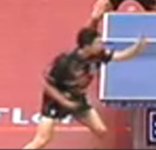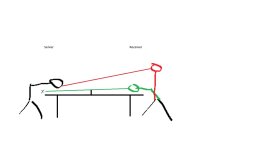says
You can check my YT channel here...
You are using an out of date browser. It may not display this or other websites correctly.
You should upgrade or use an alternative browser.
You should upgrade or use an alternative browser.
says
Spin and more spin.
says
Spin and more spin.
Well-Known Member
Super Moderator
In many of those serves, the issue is that they are tossing the ball back, away from the table, and into their body. The ball is supposed to go up, not back and not to the side. If the ball does travel sideways or back, it should go up considerably more than it drifts. In many of those tosses, the ball is going mostly back and in towards the body. A few of them may not even go up the required 6+ inches high. There is at least one where the server hits the ball before it even starts dropping. If he was making contact for the serve that low and the ball hadn't started to drop, that is definitely against the rules because part of the idea of the rule is that you cannot toss the ball at your racket to increase the spin which is exactly what happened.
The Ma Long fault is questionable. I think his ball went more up than back towards him. But it did go back towards him.
The Bastian Steger serves, I believe the call was that the ball was over the plane of the table at some point in the toss. And he was tossing for those BH serves from in front of him.
With Patrick Baum, the umpire was calling that he was blocking the view of the ball with his head. To me it looks like he probably was.
So, here are the rules.
1) The toss has to be behind the end line of the table through the whole toss.
You could think of this rule like a foot fault in regular tennis. If your foot is in the court while you are serving, it is a foot fault. In TT, if the ball is over the table during any part of the toss, it is a fault.
2) The ball needs to be tossed up at least 6+ inches. The ball needs to be tossed mostly up.
I am not sure why they leave this open to interpretation. When you toss the ball back towards your body the way every single one of those guys purposely did, you give yourself a few advantages. a) The ball going back and in towards your body allows you to generate some extra spin from the toss. b) It also allows you to hide the ball in a variety of ways because it is arcing back behind you and that makes it easy to do something like get your head between the ball and the view of the person receiving serve. So, for the TT brass to fix this issue, they would need to change the wording from mostly up to "absolutely, completely, straight up". It isn't really possible. And all the top players tosses would be illegal if that was the rule because they are all trying to toss the ball so it goes in towards the body and back away from the table.
3) No part of you should be in between the ball and the receiver. The receiver should be able to see the ball at all times on the toss for the serve.
These guys all know how to do this so smoothly that you may never realize that almost all the pros mostly serve illegally.
But the issue is compounded by the umpire not explaining very clearly what exactly each fault was so the players know what they got called on. And the issue is also compounded by poor wording in the rules about the toss.
But most top pros toss the ball, for a pendulum serve, from the midline of the table and if you drew a vertical line from the ball to the ground when the player makes contact on the serve, the ball would usually be almost at the BH side corner and about 18" farther back from the table then when it was tossed. So the drift on those tosses is about two and a half feet. If they only go up 10 inches and drift two and a half feet laterally, they are not going mostly up.
The Ma Long fault is questionable. I think his ball went more up than back towards him. But it did go back towards him.
The Bastian Steger serves, I believe the call was that the ball was over the plane of the table at some point in the toss. And he was tossing for those BH serves from in front of him.
With Patrick Baum, the umpire was calling that he was blocking the view of the ball with his head. To me it looks like he probably was.
So, here are the rules.
1) The toss has to be behind the end line of the table through the whole toss.
You could think of this rule like a foot fault in regular tennis. If your foot is in the court while you are serving, it is a foot fault. In TT, if the ball is over the table during any part of the toss, it is a fault.
2) The ball needs to be tossed up at least 6+ inches. The ball needs to be tossed mostly up.
I am not sure why they leave this open to interpretation. When you toss the ball back towards your body the way every single one of those guys purposely did, you give yourself a few advantages. a) The ball going back and in towards your body allows you to generate some extra spin from the toss. b) It also allows you to hide the ball in a variety of ways because it is arcing back behind you and that makes it easy to do something like get your head between the ball and the view of the person receiving serve. So, for the TT brass to fix this issue, they would need to change the wording from mostly up to "absolutely, completely, straight up". It isn't really possible. And all the top players tosses would be illegal if that was the rule because they are all trying to toss the ball so it goes in towards the body and back away from the table.
3) No part of you should be in between the ball and the receiver. The receiver should be able to see the ball at all times on the toss for the serve.
These guys all know how to do this so smoothly that you may never realize that almost all the pros mostly serve illegally.
But the issue is compounded by the umpire not explaining very clearly what exactly each fault was so the players know what they got called on. And the issue is also compounded by poor wording in the rules about the toss.
But most top pros toss the ball, for a pendulum serve, from the midline of the table and if you drew a vertical line from the ball to the ground when the player makes contact on the serve, the ball would usually be almost at the BH side corner and about 18" farther back from the table then when it was tossed. So the drift on those tosses is about two and a half feet. If they only go up 10 inches and drift two and a half feet laterally, they are not going mostly up.
This user has no status.
Member
says
You can check my YT channel here...
Member
says
Spin and more spin.
says
Spin and more spin.
Well-Known Member
Super Moderator
The reason I don’t believe that the cause was the height of the toss is because is toss is over his head.
The woman says, “no up the serve.” I believe she means it was not straight up.
It was up. But if you look at the toss, it arcs. It does not go straight up or close to straight up.
I could be wrong. But how she explains it seems more to do with the fact that she does not speak English too well. And I still believe that what she is trying to explain is that the serve did not go mostly up. It went up at an arc. And technically that is actually against the rules. But as I said, pretty much EVERY pro does that.
From a technical standpoint, if the hand is at the midline of the table when the ball is tossed up and when the all is coming down it is 2/3 to 3/4 of the way to the BH line, that is against the rules. Especially if it is tossed in that arc on purpose. And all the pros do that On Purpose.
But ITTF has left the wording of the rule vague and open to interpretation.
Why? I am not really sure.
And it is sad that the umpires can’t explain the rules better and it is sad that the commentators don’t even understand the rules.
Sent from The Subterranean Workshop by Telepathy
The woman says, “no up the serve.” I believe she means it was not straight up.
It was up. But if you look at the toss, it arcs. It does not go straight up or close to straight up.
I could be wrong. But how she explains it seems more to do with the fact that she does not speak English too well. And I still believe that what she is trying to explain is that the serve did not go mostly up. It went up at an arc. And technically that is actually against the rules. But as I said, pretty much EVERY pro does that.
From a technical standpoint, if the hand is at the midline of the table when the ball is tossed up and when the all is coming down it is 2/3 to 3/4 of the way to the BH line, that is against the rules. Especially if it is tossed in that arc on purpose. And all the pros do that On Purpose.
But ITTF has left the wording of the rule vague and open to interpretation.
Why? I am not really sure.
And it is sad that the umpires can’t explain the rules better and it is sad that the commentators don’t even understand the rules.
Sent from The Subterranean Workshop by Telepathy
Last edited:
says
Spin and more spin.
says
Spin and more spin.
Well-Known Member
Super Moderator
Here is the actual, applicable rule in question for Ma Long's serve.
6.2 The server shall then project the ball near vertically upwards, without imparting spin, so that it rises as least 16 cm after leaving the palm of the free hand and then falls without touching anything before being struck.
6.2 The server shall then project the ball near vertically upwards, without imparting spin, so that it rises as least 16 cm after leaving the palm of the free hand and then falls without touching anything before being struck.
Last edited:
This user has no status.
Member
If you look at Ma Long's toss @ 0:32, his free hand is above his head before the ball leaves his palm. It is not clear that the ball has traveled the requisite 16cm after the ball left his hand.
This user has no status.
Well-Known Member
says
Spin and more spin.
says
Spin and more spin.
Well-Known Member
Super Moderator
I have to agree with Carl , the ball cleared six inches but the toss was not vertical ... just look at this freeze frame it should tell you ...
View attachment 14348
Good idea. In the freeze frame, the ball is in between Maze's legs.
Here. Have a look at these:
Before the arm starts moving:
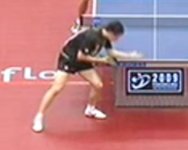
Just before the ball leaves his hand.
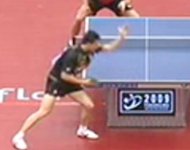
Just before the shot Monster used:
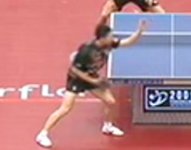
A fraction of a second after that, still before Monster's photo:
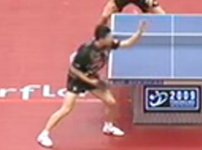
And the ball, on its way down:
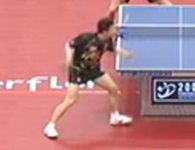
Notice:
1) Before his hand starts moving, it is 1/4 of the way from the midline towards the BH line.
2) If you draw a straight line down from where the ball is just leaving ML's hand, it is still approximately 1/3 of the way from the mid-line towards the BH line.
3) When the ball is close to its peak and before ML drops his hand at all, the ball is much more than 6 inches, or 16 cm above his hand. At that point, the ball is more than 1/2 way towards the BH line.
4) While the ball is still over ML's head and clearly dropping, it is only inches away from the BH line and if you follow the arc of the ball, which is clearly visible in the blur of the ball in that photo, it guarantees that when the ball will be more than a foot lower and ML contacts the ball, it will actually be outside the BH line.
Therefore, the lateral drift on that serve is at least 2 feet towards the BH side and we cannot measure if it goes 6 inches back away from the table or more because of the angle the serve is shown from. But all the pros do this because it helps make the ball, either hidden at some point, or so close to hidden on contact that it makes reading the serve much harder.
Last edited:
This user has no status.
Players know the rules well, but some prefer to serve at limit of the rules.
When players meet a very exigent unpire, most of them respect the demand of the unpire. Ma Long was smart enough to see of his game. But some of them prefer to argue with referee.
Ding Ning lose the Final at London Olympics because of incorrect services:
See directly on youtube !
"https://youtu.be/TfzHkO7XtC0?t=2504"
"https://youtu.be/TfzHkO7XtC0?t=487"
Faulty services in junior boys singles final (EYC 2015):
Watch the next match from 09:20, when CASSIN Alexandre serve with face to unpire. Of corese, the refeere is exaggerated of exigent, but the rule is on his side.
https://tv.ittf.com/video/huang-chien-tu-tpe-cassin-alexandre-fra/700678
When players meet a very exigent unpire, most of them respect the demand of the unpire. Ma Long was smart enough to see of his game. But some of them prefer to argue with referee.
Ding Ning lose the Final at London Olympics because of incorrect services:
"https://youtu.be/TfzHkO7XtC0?t=2504"
"https://youtu.be/TfzHkO7XtC0?t=487"
Faulty services in junior boys singles final (EYC 2015):
Watch the next match from 09:20, when CASSIN Alexandre serve with face to unpire. Of corese, the refeere is exaggerated of exigent, but the rule is on his side.
https://tv.ittf.com/video/huang-chien-tu-tpe-cassin-alexandre-fra/700678
Last edited:
This user has no status.
Active Member
A lot of players, especially amateurs, complain about opponents' fault services and that there is nothing one could do against it. Here we see umpires that DO take action against fault services but still a lot of people call that "ridiculous" and too stubborn etc. So, what do those people want?
I love umpires that have the guts to call those fault services and if a players does not change that the umpire should call every single service. That is a great umpire!
Professional players who start to argue about those calls - bad behaviour in my opinion. They all know that they train every day to serve at the limits of the rules or even beyond those rules. If an umpire calls your services for that they should feel caught, accept it and serve correctly. Every pro player can do that.
I love umpires that have the guts to call those fault services and if a players does not change that the umpire should call every single service. That is a great umpire!
Professional players who start to argue about those calls - bad behaviour in my opinion. They all know that they train every day to serve at the limits of the rules or even beyond those rules. If an umpire calls your services for that they should feel caught, accept it and serve correctly. Every pro player can do that.
This user has no status.
Well-Known Member
On this topic , with due respect to her and her past achievements ... this is the worst behavior I have seen personally , given the context ..... and somewhere along the line the commentators did mention that she was coming out of retirement to specifically help her new club earn some more members ... not sure how this kind of behavior helped that ... and from what I hear and the looks of her playing she was really good in her prime ...
A lot of players, especially amateurs, complain about opponents' fault services and that there is nothing one could do against it. Here we see umpires that DO take action against fault services but still a lot of people call that "ridiculous" and too stubborn etc. So, what do those people want?
I love umpires that have the guts to call those fault services and if a players does not change that the umpire should call every single service. That is a great umpire!
Professional players who start to argue about those calls - bad behaviour in my opinion. They all know that they train every day to serve at the limits of the rules or even beyond those rules. If an umpire calls your services for that they should feel caught, accept it and serve correctly. Every pro player can do that.
says
Spin and more spin.
says
Spin and more spin.
Well-Known Member
Super Moderator
says
Spin and more spin.
says
Spin and more spin.
Well-Known Member
Super Moderator
Here are all the rules for service:
06 Service
6.1 Service shall start with the ball resting freely on the open palm of the server's stationary free hand.
6.2 The server shall then project the ball near vertically upwards, without imparting spin, so that it rises as least 16 cm after leaving the palm of the free hand and then falls without touching anything before being struck.
6.3 As the ball is falling, the server shall strike it so that it touches first his court and then, passing directly over or around the net assembly touches the receiver's court. In doubles the ball shall touch successively the right half court of the server and receiver.
6.4 From the start of service until it is struck, the ball shall be above the level of the playing surface and behind the server's end line, and it shall not be hidden from the receiver by any part of the body or clothing of the server or his doubles partner.
6.5 It is the responsibility of the player to serve so that the umpire or the assistant umpire can see that he complies with the requirements for a good service.
6.5.1 If there is no Assistant Umpire, and the umpire is doubtful of the legality of a service he may, on the first occasion in a match, warn the server without awarding a point.
6.5.2 If subsequently in the match a service by that player or his doubles partner is of dubious legality, for same reason or for any other reason, the receiver shall score a point.
6.5.3 Whenever there is a clear failure to comply with the requirements for a good service, no warning shall be given and the receiver shall score a point.
6.5.4 Exceptionally, the umpire may relax the requirements for a good service where he is satisfied that compliance is prevented by physical disability.
6.6 If, in attempting to serve, a player fails to strike the ball while it is in play, his opponent will be awarded a point.
Sent from The Subterranean Workshop by Telepathy
06 Service
6.1 Service shall start with the ball resting freely on the open palm of the server's stationary free hand.
6.2 The server shall then project the ball near vertically upwards, without imparting spin, so that it rises as least 16 cm after leaving the palm of the free hand and then falls without touching anything before being struck.
6.3 As the ball is falling, the server shall strike it so that it touches first his court and then, passing directly over or around the net assembly touches the receiver's court. In doubles the ball shall touch successively the right half court of the server and receiver.
6.4 From the start of service until it is struck, the ball shall be above the level of the playing surface and behind the server's end line, and it shall not be hidden from the receiver by any part of the body or clothing of the server or his doubles partner.
6.5 It is the responsibility of the player to serve so that the umpire or the assistant umpire can see that he complies with the requirements for a good service.
6.5.1 If there is no Assistant Umpire, and the umpire is doubtful of the legality of a service he may, on the first occasion in a match, warn the server without awarding a point.
6.5.2 If subsequently in the match a service by that player or his doubles partner is of dubious legality, for same reason or for any other reason, the receiver shall score a point.
6.5.3 Whenever there is a clear failure to comply with the requirements for a good service, no warning shall be given and the receiver shall score a point.
6.5.4 Exceptionally, the umpire may relax the requirements for a good service where he is satisfied that compliance is prevented by physical disability.
6.6 If, in attempting to serve, a player fails to strike the ball while it is in play, his opponent will be awarded a point.
Sent from The Subterranean Workshop by Telepathy
Last edited:
This user has no status.
This user has no status.
Member
[...]and it shall not be hidden from the receiver[...]
So if I stand straight up I can make my opponents serve illegal (if he's bending over the ball to a certain extent) as opposed to bending forward to lower my vision? What if I jump? And I thought it had something to do with the net as fixed angle points. My bad!
And I thought it had something to do with the net as fixed angle points. My bad!
Then again it's impossible for the umpire to be sure in so many, many cases. That's what the other rules are implying and why they are there in the first place. These rules make a lawyer rub his hands together. Props to those that stay strict and consistent and don't give in to the crowd's booing or players' whining.
So if I stand straight up I can make my opponents serve illegal (if he's bending over the ball to a certain extent) as opposed to bending forward to lower my vision? What if I jump?
Then again it's impossible for the umpire to be sure in so many, many cases. That's what the other rules are implying and why they are there in the first place. These rules make a lawyer rub his hands together. Props to those that stay strict and consistent and don't give in to the crowd's booing or players' whining.
says
Spin and more spin.
says
Spin and more spin.
Well-Known Member
Super Moderator
So if I stand straight up I can make my opponents serve illegal (if he's bending over the ball to a certain extent) as opposed to bending forward to lower my vision?
If the ball passes between his body and you so the view of the ball is obscured for any part of the toss and serve, THE SERVE IS AGAINST THE RULES. So it makes no difference if you are higher or lower, if at any point, the view is obscured, it is against the rules.
If you are higher, but not to the right of your original position, (if you are a righty), the body will simply be in the way of the ball till later in the toss: if the body is ever in the way of the ball.
If you are lower, you will likely see when the ball falls under the opponent’s obscuring body part before the serve contact. So you are better able to see and receive the serve. But it is still against the rules if any part of the server gets between your eyes and the ball at any point in the serve.
If you move towards your FH side, to receive, a ball that was visible from the BH side may be blocked from the FH side.
So this does mean that the view of the ball could be blocked for a lefty and not a righty.
Most pros, the way they serve, at some point in the descent of the ball on the toss, obscure the view with their head. The ball passes behind their head on its way down.
The pros that do that kind of toss that arcs towards the BH while the are bent forward ALL do this.
It is not often called. But it is still against the rules.
Sent from The Subterranean Workshop by Telepathy
Last edited:
This user has no status.
Well-Known Member
I completely agree with you , I have a very good friend who consistently hits the the ball behind his head and thinks he is serving great ... I told him a couple of times and his response was "I never get called in tournaments" and he is at the higher end of adults who frequently play tournaments ... after that I stopped warning him ... because it just makes the situation complicated between friends and I for one is not that crazy about winning .... the sad part of this is if umpires don't call properly in tournaments, and in USA we only have mandatory umpires from knockout stages in most tournaments , the culture of illegal serving will thrive ... I know Larry Hodges has tried his best to turn things around but it seems nobody in the USATT board seems to be interested in fixing such "small" problems with the sport ...
If the ball passes between his body and you so the view of the ball is obscured for any part of the toss and serve, THE SERVE IS AGAINST THE RULES. So it makes no difference if you are higher or lower, if at any point, the view is obscured, it is against the rules.
If you are higher, but not to the right of your original position, (if you are a righty), the body will simply be in the way of the ball till later in the toss: if the body is ever in the way of the ball.
But this does mean that the view of the ball could be blocked for a lefty and not a righty.
Most pros, the way they serve, at some point in the descent of the ball on the toss, obscure the view with their head. The ball passes behind their head on its way down.
The pros that do that kind of toss that arcs towards the BH while the are bent forward ALL do this.
It is not often called. But it is against the rules.
Sent from The Subterranean Workshop by Telepathy
Last edited:
says
Spin and more spin.
says
Spin and more spin.
Well-Known Member
Super Moderator
.... but it seems nobody in the USATT board seems to be interested in fixing such "small" problems with the sport ...
Nobody in ITTF either!!!!!! Not sure which is the bigger problem.
Sent from The Subterranean Workshop by Telepathy
This user has no status.
Well-Known Member
... and then you have these veterans of the sport setting an excellent example of how to put pressure on the umpire ... infact I would argue , the umpire should have called in the first instance itself when she tossed it back to her body , I guess he did not because he wanted to have a clear view ..
Nobody in ITTF either!!!!!! Not sure which is the bigger problem.
Sent from The Subterranean Workshop by Telepathy
Similar threads
- Replies
- 18
- Views
- 556
- Replies
- 6
- Views
- 658
- Replies
- 2
- Views
- 2K
- Replies
- 4
- Views
- 130






